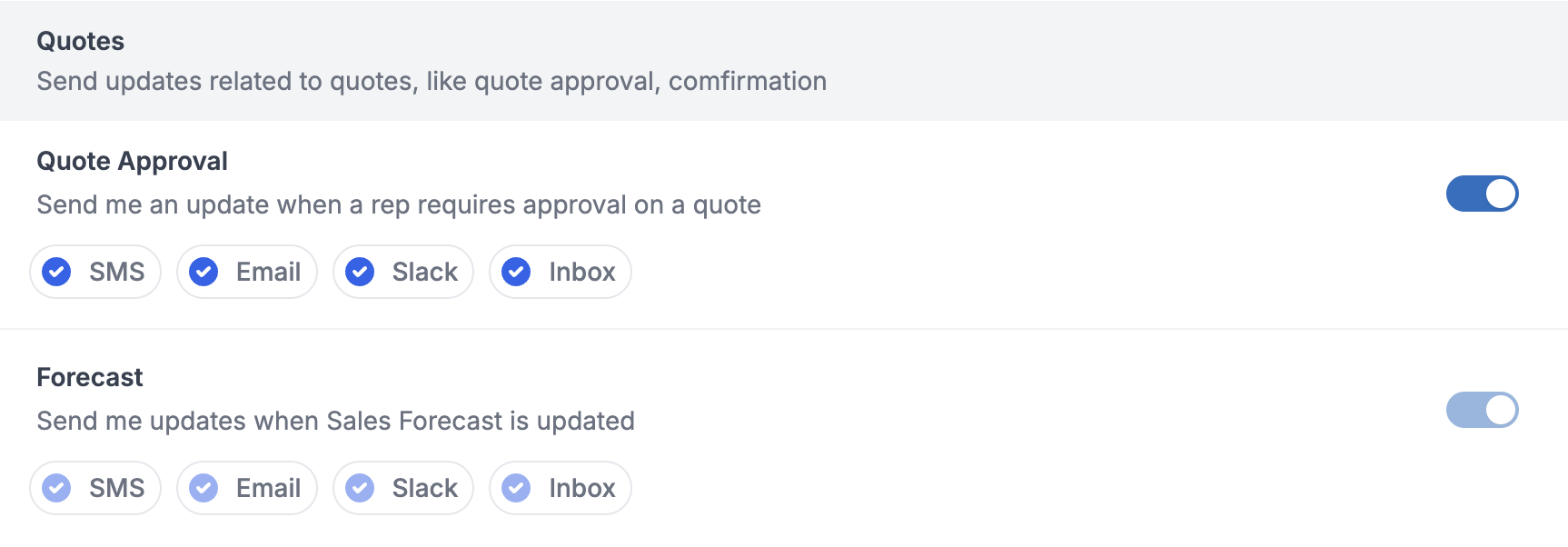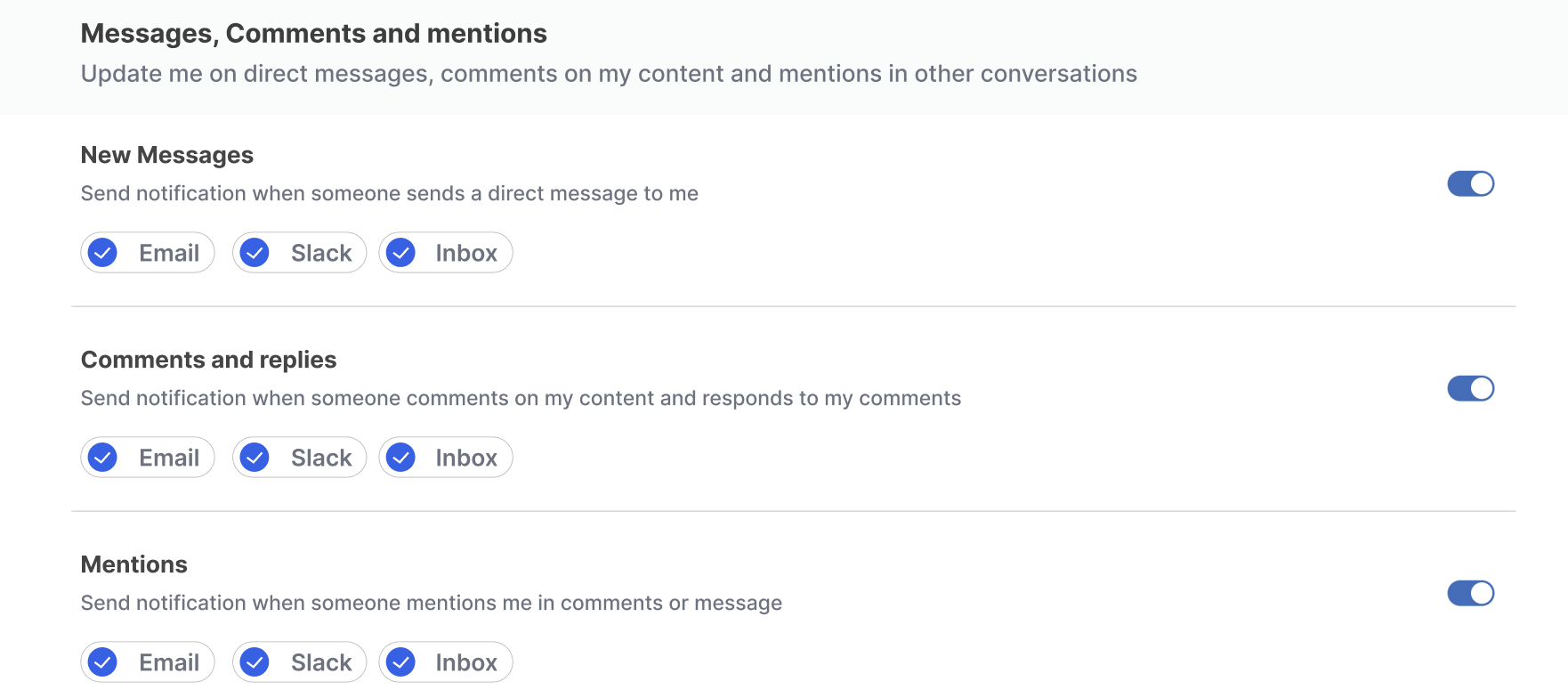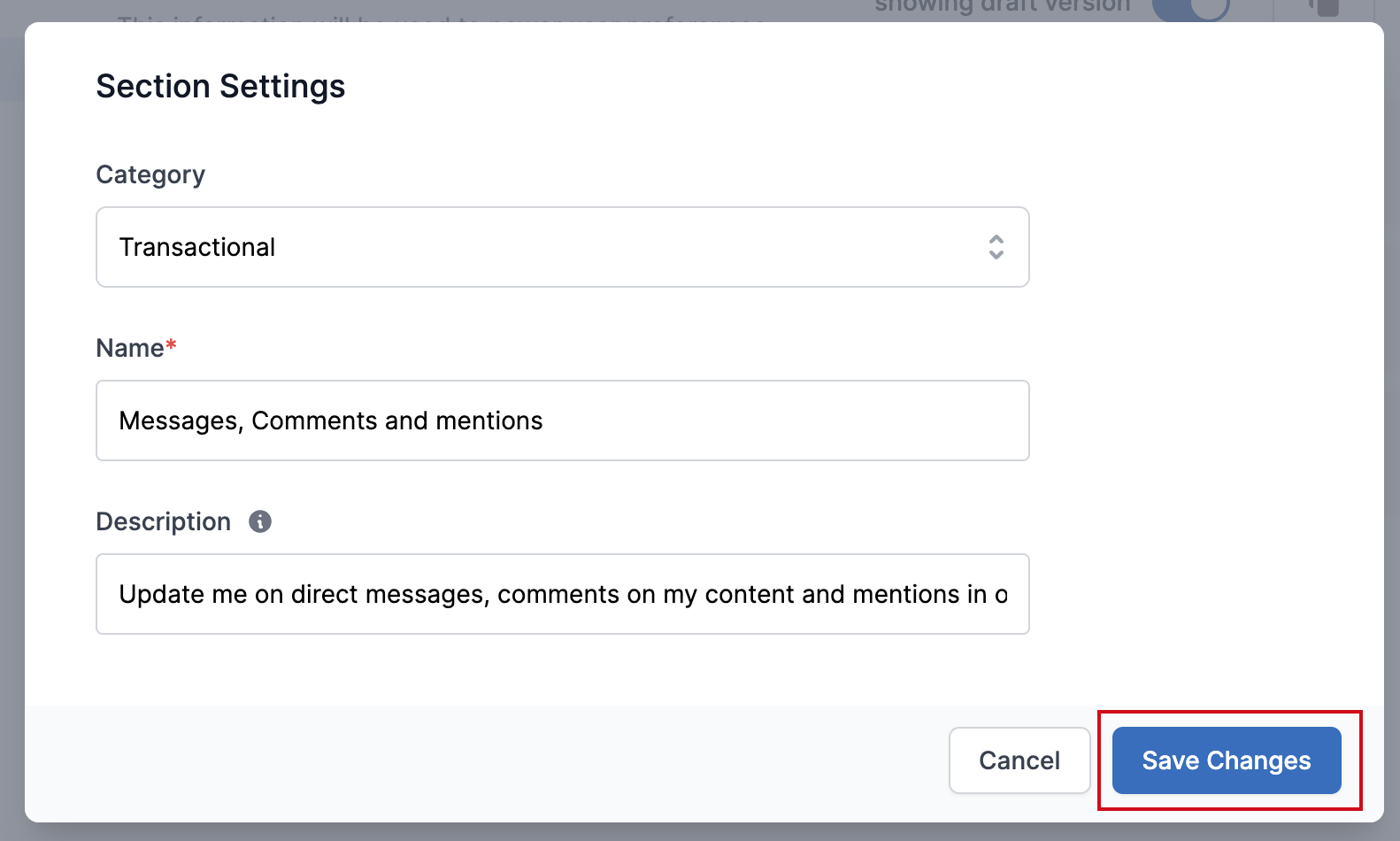Notification Category
Learn what notification categories mean and how you can use it for user preferences
Notification Categories are the category your workflow belongs to. It is used for following purposes:
- Defining notification latency: We maintain separate notification queues for different notification category to ensure that marketing and promotional notifications doesn't delay system or time-sensitive notifications.
- Setting category-level preferences per-user and tenant: You can create sub-categories for different type of notifications and give your users option to set their notification preferences at category level.
- Setting category-level rules or limits: For example, you can set a rule that all notifications in promotional category should only be sent between 10 am - 5 pm or the max notifications in the category should not exceed 100k per day.
Top-level Categories
SuprSend has 3 broad notification categories - System, Transactional and Promotional. Notifications rules and latency settings are defined at these top level categories. You can create further sub-categories in each of these categories to power user preferences.
System
System notifications are the ones that are essential for your users to use your website and can't be unsubscribed by the users. These notifications are considered most time-sensitive and given the highest priority in notification send queues. Some examples are - OTP, Forgot Password and Verification emails.
Transactional
Transactional notifications are the ones that are sent in response to some user transaction or action on your platform. By default, users are subscribed to transactional notifications and not allowed to unsubscribe as they have initiated them at the first place. However, some of the transactional notifications are not so critical and can be unsubscribed as per user's wish (eg. Post likes/ comments). You can set which transactional notifications are critical and should not be allowed to unsubscribe by setting the default preference as cant unsubscribe.
These notifications are considered second in priority in notification queues after system notifications.
Some examples are - Delivery updates, Payment Confirmation, booking confirmation, Post shared / liked, Balance alerts, account update alert, and reminders.
As a company, you should make sure that you use strategies like batching & channel routing, so that users do not feel bombarded with transactional notifications. Also, you can cleverly use transactional communications to up-sell, cross-sell, collect feedback, or bring your user back to your platform.
Channel providers do not block transactional communications generally, and consider your users to be implicitly agreeing to these notifications, hence transactional communications should be used judiciously.
Sending notifications that are not related to user transaction but are very personal to user's profile and interests, like recommended products, cart abandoned, etc could be inferred as transactional, depending on indicators like whether user is subscribed to receive them, or the way content is designed.
Promotional
Promotional notifications are the ones that are sent out to users to increase sales, promote products, or bring users back to your platform without user doing any interaction in the first place. These communications are generally sent in bulk, consuming a significant portion of the communication pipeline. That's why they are given the least priority in notification queue. You should always send your bulk messages and broadcasts in promotional category so that it doesn't impact the latency of your system and transactional notifications.
Some examples are: Newsletters, announcements, product updates, upcoming sale or event, deals and discounts, or price drop alerts.
Some channel providers often require explicit users permission to send these communications. Other channel providers could block or tag these communication as promotional marketing.
Creating sub-categories for preference management
You can create notification categories from Developers -> Notification categories page. All sub-categories are created in the 3 top level categories mentioned above. Notification rules and latency priority are inherited from the top level category. Preference settings are defined at each sub-category level. Top level categories are not shown on the preference page.
Every category can have sections and sub-categories. User preferences are controlled at the sub-category level.
- Sub-category is what end users will see on their preference page.
- Sections are used to group related sub-categories on the preference page, facilitating easier navigation and organization on the preference page.
For instance, in the below example, Quote Approval and Forecast are sub-categories and Quotes is the section in which these sub-categories are grouped.


Updating Section
You can update section in any category by clicking on the "+Section" button in each category

Add name and description for the category and "Save Changes". You'll see the updated section inside the category and edit it later by clicking on the "Edit" button against that section.
Updating Sub-Category
Sub-Category default preferences vary based on the category that you are adding in.
- System category default preference is set to "Can't Unsubscribe" with "All" user channels set as mandatory. Users will not be allowed to update preferences in this category as system notifications are critical notifications and should always be sent to the user.
- Transactional category default preference is set to "Can't Unsubscribe". We recommend selecting at least one mandatory channel for the transactional category since users should receive notifications on at least one channel corresponding to a transaction. However, you are free to set any default preference in this category.
- Promotional category default preference is set to ON. This means that the user will receive notification in this category by default. You can't set this category to Can't Unsubscribe as users should always be able to opt-out of marketing-related notifications.
You can update sub-category in any category by clicking on the "+Sub-Category" button in that category.

| Field | Obligation | Description |
|---|---|---|
| Name | Mandatory | Name of the sub-category to be shown on the user preference page |
| Section | Optional | Section in which this sub-category will be grouped into |
| Description | Optional | Description of the sub-category to be shown on the user preference page |
| Default Preference | Mandatory | Default preference settings for the sub-category. Notifications will be sent to the user based on this preference until the user overrides it - On means the user will get notifications on all channels in this sub-category until user opts out from this category or any channel in this category - Off means the user will not get notification on all channels in this sub-category until user opts into this category or any channel in this category - Can't Unsubscribe means the user can't completely opt-out from this category. Notifications will always be sent on mandatory channels in this category. |
| Mandatory Channels | Optional | Mandatory channels from which user Can't Unsubscribe. The default selection is All but you can change it to Selected Channels only to make specific channels mandatory. |
Click on "Save Changes" to save the sub-category. You'll see the updated sub-category inside the section and edit it later by clicking on the pencil icon against that category.
Avoid Changing sub-category name
Changing category name updates the category slug. So, make sure to not change sub-category name once you have configured it in your workflows or if it is absolutely necessary to change the name, change it in all backend and front workflows otherwise the workflows will start failing.
Preview Changes
Click on Preview to see a reference view of ready-made preference center for your end user. Please note that this view is just for reference of how the categories and sections will be placed in end user's view. Actual view will be based on the preference page design in your application.
Publish Changes
All the changes done are saved in draft version. You can publish the changes to make it live for your end users. You'll be able to add the updated categories in workflow call only after publishing the changes.
Click on Publish Changes button to publish the changes.
Clone Categories to production workspace
You can test preferences in your staging application and use "Clone" button to clone the changes to production workspace.
Triggering notification for a sub-category
You can add sthe ub-category slug in notification_category field in your backend workflow call or select the category from dropdown in workflows created through SuprSend dashboard.
You can copy sub-category slug by clicking on sub-category name on the category settings page

Updated 9 months ago
